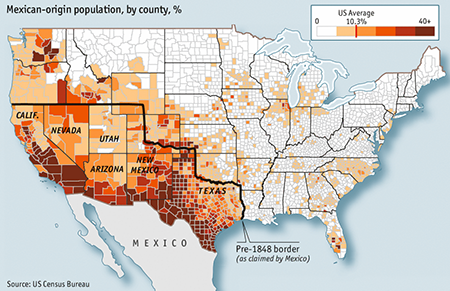Reclaiming the Southwest from the gringos
The February 1, 2014 Economist presented a short anti-American article and map explaining how Mexicans "didn’t jump the border - it jumped them".
The article - essentially a legalization / amnesty propaganda piece - states:
On February 2nd 1848, following a short and one-sided war, Mexico agreed to cede more than half its territory to the United States. An area covering most of present-day Arizona, California, Nevada, New Mexico and Utah, plus parts of several other states, was handed over to gringolandia. The rebellious state of Tejas, which had declared its independence from Mexico in 1836, was recognised as American soil too. But a century and a half later, communities have proved more durable than borders. The counties with the highest concentration of Mexicans (as defined by ethnicity, rather than citizenship) overlap closely with the area that belonged to Mexico before the great gringo land-grab of 1848. Some are recent arrivals; others trace their roots to long before the map was redrawn. They didn’t jump the border—it jumped them.
The racist anti-American bias is clearly evident in the article, which percolates the article with the terms "gringolandia" and "gringo". Americans (of all races and colors) are expected to take this without so much as a whimper. Yet one could imagine the uproar from race-based nationalist groups had the Economist written that "Some spics are recent arrivals...".
The implication of the map and the article is that the United States should cede the Southwest US back to Mexico. Yet the article itself points out that Texas seceded from Mexico long before the short 1848 war. Unfortunately, the article, in a glaring omission, failed to note that the US paid Mexico for the territory:
In February of 1848 the two sides agreed on the Treaty of Guadalupe Hidalgo. Mexico was forced to sign over all of California, Utah and Nevada as well as parts of New Mexico, Arizona, Wyoming and Colorado in exchange for $15 million dollars and exoneration of about $3 million more in previous liability. The Rio Grande was established as the border of Texas. People living in these territories, including several tribes of Native Americans, reserved their properties and rights and were to be given US citizenship after a year. Lastly, future disagreements between the US and Mexico would be settled by mediation, not warfare.
- The Mexican-American War - About.com
Mexican-Americans continued to live in the new United States teritory and the vast majority became US citizens. Only 4 percent of Mexico's population - 80,000 - lived in the territory at the time of the treaty!
Yet as the above map shows, a large percentage of the Southwest US population is of "Mexican-origin". The map does not tell us the proportion of that population resulting from the fertility of those initial 80,000, versus the proportion resulting from illegal immigration and the fertility of illegal aliens.
The United States has sovereign control over all of its states and territories. It simply fails to exercise that control.
CAIRCO Research
Book Review: Spiraling Toward Chaos - a review of:
Wakeup Call From Mexico
An Historical and Contemporary Understanding of Mexico’s Pandemic Violence, Drug War, Kidnappings, and Illegal Immigration; How to Safeguard America as America Spirals Toward Chaos
By Wilson Beck
by Fred Elbel, The Social Contract, Winter 2009-2010.
Occasionally, a book is published which, while providing a myriad of details on a subject matter, also conveys the complete gestalt — the big picture. Wakeup Call From Mexico is such a book. Immensely readable, this book describes Mexico’s violent history, its class-based society, its ineffective and corrupt political system, and the serious threat that Mexico as a nearly failed state poses to the United States. The historical perspective alone makes this book required reading for all concerned with U.S.-Mexico relations and unending illegal immigration across the unsecured U.S.-Mexico border.

